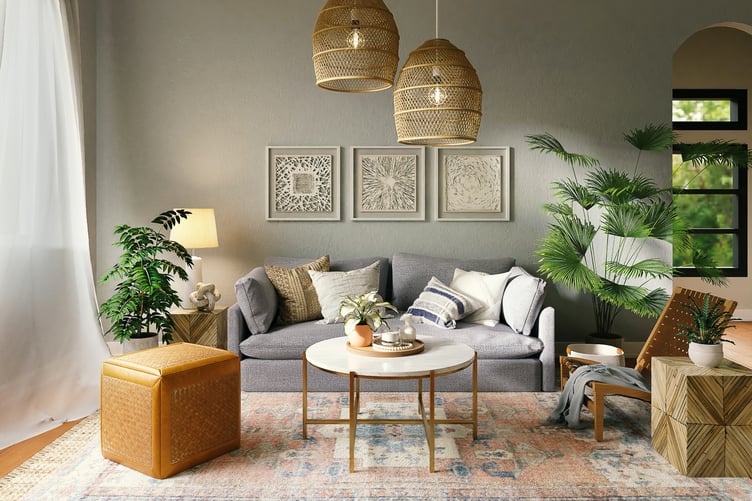When you’re picking your forever home, it’s easy to become overwhelmed by all of the details.
As well as the things that immediately come to mind - the amount of rooms, the garden space and the house’s location - there are plenty of smaller details that you should check before committing to buy.
We’ve collated a handy list of what to look out for, covering everything from the roof to the floors.
House structure
1. Sagging ceilings
As you look around the house, remember to glance up - as the state of the ceilings can often be telling. If the ceilings are sagging even a little, this could be a sign of water damage, termites, improperly installed drywall or foundation issues. If left unchecked, a sagging ceiling could collapse.
2. Flooring
There are several things to note about the flooring in a house you are considering buying, including levelness of the floors, squeaking, any warping or bowing, water damage near external doors, and loose tiles. These issues can be indicative of poor workmanship laying the floors, an excess of moisture and sometimes foundational issues.
3. Brickwork
Look for crumbling brickwork or missing bricks on the outside of the house - and the inside if there is exposed brickwork. This can be a structural issue and can be indicative of excessive wear and tear on the house.
4. Cracks
Keep your eyes peeled for cracks in the paint and walls. Sometimes, cracks in paint are no big issues - the paint might have been a DIY project gone awry - or they could signal that the home is prone to damp, while cracks in the walls can indicate structural or foundational defects.
External
5. Roofing
While it might not be possible for you to get up on the roof during a house viewing, it’s worth taking a look from the best angle you can find. See if there are any visible missing or cracked tiles. If you get the chance while inside, see if you can access the loft to check whether there is any damp coming through, or visible sunlight through the roof.
6. Drains and gutters
Make sure that the roof gutters all lead to storm drains. If not, then you could be left with puddles of rainwater settling in your garden, or in the worst case, you could be left open to flooding - which would cause a whole host of problems.
Internal features
7. Plug sockets
Check that there are enough plug sockets throughout the house. Of course, you can always use plug extenders - but overloading one socket can be dangerous. While you’re looking at plug sockets, make sure that they look healthy - with no cracks or loose screws.
8. Windows
When you are looking at the windows, close one and hold your hand in front of it. If you can feel a breeze from it, it is not properly sealed. Another thing to look out for in windows is the double glazing. If you can see condensation that is in between the two layers of the window, this means that the double glazing has “blown” and the house may require new windows.
9. Signal
One thing that could be easy not to pick up on until you’ve already moved in is what kind of phone and internet signal the house gets. In each room, check your phone to make sure that you are still receiving signal. This is especially important if you work from home - as you wouldn’t want to be unable to receive calls in your new home office.
Utilities
10. Water pressure
When you get the chance to do so, turn on one of the taps - preferably a hot water tap. This will give you an idea of what the water pressure is like and how quickly the water heats up. If the water pressure is weak, you may have to replace the boiler after moving in, which can be costly.
11. Ask for electric, gas and EPC certificates
These documents should be provided to you so that you can see what kind of utilities the building uses, how much they cost and how energy efficient they are.
12. Council tax band
Finding out what council tax band your potential new house is in is important, as this will add to your outgoing costs. When thinking about the price of the house, remember to consider costs like tax and utilities, as this will give you a better idea as to its affordability.
Other
13. Mould and damp
Mould is not always immediately apparent as you walk into a home. Check out the corners of windows, skirting boards and ceilings to get an idea of whether the house is prone to mould. This can often be due to damp, and can be difficult to get rid of. Make sure to also look inside cupboards and cabinets to see if there is a damp smell.
14. Storage space
Does the house have enough storage space? You may have furniture that can be used for storage, but bear in mind that if there are no cupboards throughout the house, many of your rooms may feel smaller with those extra belongings - or extra furniture - in them.
15. Neighbourhood
Most problems in a home you can change - but the neighbourhood is something you cannot fix. Take a walk around the streets near your potential new home, and see whether you feel safe, whether the people are welcoming, and whether there are any local features that would draw you to or away from the area. For instance, if there is a nightclub down the street or a chemical processing plant, these could affect your happiness in your new home, while equally, a nearby park or corner shop could be just what you are looking for.
Got any other tips for new home buyers? Leave them in the comments below.



.png?width=209&height=140&crop=209:145,smart&quality=75)
